Hello Folks, thanks for the lovely feedback I got from my August newsletter. For September, I offer my continuing adventures across the pond regarding time spent in Ireland this summer. In October, I will return to my usual style newsletter.
I absolutely adore Ireland, and have traveled there as often as possible to explore ancient, megalith sites since my first visit in 2006. I have met and stayed in contact with several fine people there. My friends, Carole and Sean offered for me to stay with them in Dublin and leave my large suitcase with them as I traveled. What an offer!
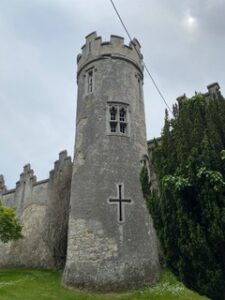 Carole and Sean took me to see Howth Castle, where Grace O’Malley, the fabulous pirate queen had once stopped off and was denied customary hospitality and meal by St. Lawrence, Earl of Howth. She abducted the duke’s grandson from the beach for Howth’s display of disrespect. Suffice to say that the duke ate humble pie to retrieve his treasured heir. We visited with the former owner’s wife, who told us it is very cold living in the castle.
Carole and Sean took me to see Howth Castle, where Grace O’Malley, the fabulous pirate queen had once stopped off and was denied customary hospitality and meal by St. Lawrence, Earl of Howth. She abducted the duke’s grandson from the beach for Howth’s display of disrespect. Suffice to say that the duke ate humble pie to retrieve his treasured heir. We visited with the former owner’s wife, who told us it is very cold living in the castle.
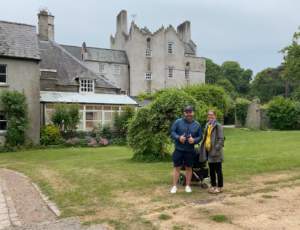 Very near the castle was a gigantic dolmen. (Dolmen – portal tomb: a single-chamber megalithic tomb, usually consisting of two or more upright stones supporting a large flat horizontal stone). These were originally covered over with dirt, but no longer are. Many of them have fallen over. This one was named Aideen’s Grave. Aideen was married to the mighty warrior, Oscar, son of Oisin, son of Fionn Mac Cumhaill AKA Finn McCool. When Oscar was killed in battle, Aideen died of grief. While dolmens were usually erected for kings, Oisin was so touched by her loyalty to his son that he built her this tomb…or so the story goes. It is very different than the limestone ones I had seen in the past, as it was carved of granite with a rough, rounded top.
Very near the castle was a gigantic dolmen. (Dolmen – portal tomb: a single-chamber megalithic tomb, usually consisting of two or more upright stones supporting a large flat horizontal stone). These were originally covered over with dirt, but no longer are. Many of them have fallen over. This one was named Aideen’s Grave. Aideen was married to the mighty warrior, Oscar, son of Oisin, son of Fionn Mac Cumhaill AKA Finn McCool. When Oscar was killed in battle, Aideen died of grief. While dolmens were usually erected for kings, Oisin was so touched by her loyalty to his son that he built her this tomb…or so the story goes. It is very different than the limestone ones I had seen in the past, as it was carved of granite with a rough, rounded top.
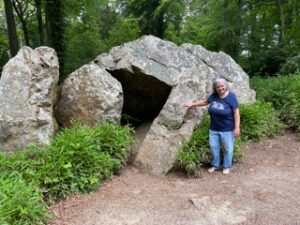 Carole gave me lessons on how to take the train into town, and I was pleasantly surprised at how cheap and easy it was. We went into Dublin for a bit of shopping and to see Trinity College for a tour. Since I had already seen the Book of Kells (amazing!) and the massive library (amazing!), we walked the tree-lined campus, viewing various architecture and listened to our student hostess regal us with funny stories. There happened to be, in the 1700s, an attempt by students to murder a very unpopular school dean. Wow! I had certainly fantasized about a certain dean at Texas Chiropractic College, but never actually made plans like these lads did.
Carole gave me lessons on how to take the train into town, and I was pleasantly surprised at how cheap and easy it was. We went into Dublin for a bit of shopping and to see Trinity College for a tour. Since I had already seen the Book of Kells (amazing!) and the massive library (amazing!), we walked the tree-lined campus, viewing various architecture and listened to our student hostess regal us with funny stories. There happened to be, in the 1700s, an attempt by students to murder a very unpopular school dean. Wow! I had certainly fantasized about a certain dean at Texas Chiropractic College, but never actually made plans like these lads did.
I visited 4 days with Ali Isaac, an English transplant who has lived in Ireland with her Irish husband and three children for more years than she lived in England and is getting her citizenship. I stayed in the old town of Cavan north of Dublin near her home.
Ali took me to Tlachtga (pronounced Clackda), AKA The Hill of Ward, an ancient earth mound in Co. Meath unlike any other I had ever seen. It dates back to the stone age. We climbed over a stile and into an unmarked pasture. Like many of Ireland’s archaic treasures, a farmer was running sheep and horses on it and we had to watch our step. A lamb followed me, baa-ing as he went, and I’ll admit I was charmed and wanted to scratch his head. The structure is on probably 1 acre of land. The centerpiece was round, flat-topped, and elevated. There were three concentric circles around it built up with stone and dirt, and each ridge wide enough at the top for 2 people side-by-side to walk around. Below were ditches to 8-10 ft. deep. It was clearly a powerful site, which took untold man hours to build. Associated with Samhain (pronounced SAH win), many think of it as a ceremonial site, but that didn’t make sense to me. Aw, where is my time machine? Take a look here: https://www.discoverboynevalley.ie/boyne-valley-drive/heritage-sites/tlachtga-hill-ward-athboy
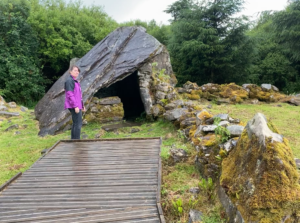 Ali and I made a pact to ask for 3 nights in a row for our angels and guides to enter our dreams and show us what the site was used for. The first night, I dreamed of 3 friends joining me for board games. What? The next night, I dreamed of 7 friends joining me in playing board games. On the third night, I dreamed my house was filled with people playing all sorts of games. So, there you have it! Tlachtga was a tournament center.
Ali and I made a pact to ask for 3 nights in a row for our angels and guides to enter our dreams and show us what the site was used for. The first night, I dreamed of 3 friends joining me for board games. What? The next night, I dreamed of 7 friends joining me in playing board games. On the third night, I dreamed my house was filled with people playing all sorts of games. So, there you have it! Tlachtga was a tournament center.
The next day, Ali drove me to the prehistoric Cavan Burren Park. It is a beautiful area with many trees and quite a few dolmens of various shapes. The largest had fallen off on one side, and is called The Calf House Dolmen due to a farmer once keeping his calves there. I could only imagine the original inhabitant rolling over in his grave if he had space to, considering there were calves stomping the ground. There were other dolmens, and it was clear this was considered a sacred area by the ancient ancestors. After visiting several cairns, it began to sprinkle and then, unfortunately, to rain in earnest. We left before seeing it all.
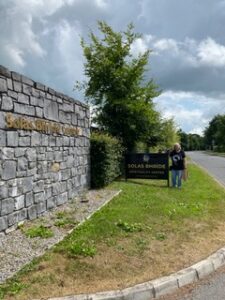 Ali took me to Kildare to see Brigid’s perpetual sacred flame, which had its beginning in pre-Christian time. Brigid was a goddess whom the Irish people revered and invoked to protect their herds and to provide a fruitful harvest. The church co-opted this goddess, as they couldn’t get the Celts to stop worshipping her. She became St. Brigid. The fire had burned non-stop, tended by the nuns of Kildare, who were dedicated to Brigid until that villain, Henry VIII, destroyed their sanctuary in the 1600s. The sacred fire was re-lit in 1993 by the Brigadine sisters and has burned non-stop since then. For years, the flame was located in a private home, but there is now a beautiful sanctuary, Solas Bhride Centre, to house the flame, with classrooms and lush flower gardens. I bought a candle there and lit it from the flame to carry home to my friends, family, and clients.
Ali took me to Kildare to see Brigid’s perpetual sacred flame, which had its beginning in pre-Christian time. Brigid was a goddess whom the Irish people revered and invoked to protect their herds and to provide a fruitful harvest. The church co-opted this goddess, as they couldn’t get the Celts to stop worshipping her. She became St. Brigid. The fire had burned non-stop, tended by the nuns of Kildare, who were dedicated to Brigid until that villain, Henry VIII, destroyed their sanctuary in the 1600s. The sacred fire was re-lit in 1993 by the Brigadine sisters and has burned non-stop since then. For years, the flame was located in a private home, but there is now a beautiful sanctuary, Solas Bhride Centre, to house the flame, with classrooms and lush flower gardens. I bought a candle there and lit it from the flame to carry home to my friends, family, and clients.
 From there, we went to see Maynooth College (Ali’s alma mater) and the 800-year-old yew tree thought to be the oldest in Ireland that I had been hearing about. Called Silken Thomas Yew, it was planted at the time of the crusades and has overseen the Hundred Years War, the Fall of Constantinople, the Renaissance, the Reformation, Age of Enlightenment, and the emergence of the modern era. It’s a monster! I understand that, centuries ago, the land was covered with yew. However, its needles are poisonous to cattle, and most were eradicated. These days, one mostly sees them next to churches.
From there, we went to see Maynooth College (Ali’s alma mater) and the 800-year-old yew tree thought to be the oldest in Ireland that I had been hearing about. Called Silken Thomas Yew, it was planted at the time of the crusades and has overseen the Hundred Years War, the Fall of Constantinople, the Renaissance, the Reformation, Age of Enlightenment, and the emergence of the modern era. It’s a monster! I understand that, centuries ago, the land was covered with yew. However, its needles are poisonous to cattle, and most were eradicated. These days, one mostly sees them next to churches.
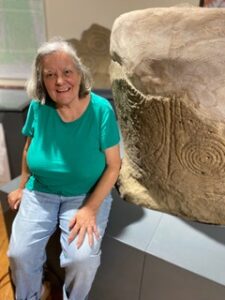 Alas, tickets to the summer solstice event were sold out. However, the museum where Ali worked, Cavan Co Museum, was open and full of treasure! For years, I had wanted to see the Killygluggin Stone. The Killigluggin Stone is one of three in Ireland done in the La Teine style – huge stones deeply engraved with a scrolling style considered to be of Swiss origin. It is believed these stones were originally covered in beaten gold. This one is broken, but fortunately, they have both pieces.
Alas, tickets to the summer solstice event were sold out. However, the museum where Ali worked, Cavan Co Museum, was open and full of treasure! For years, I had wanted to see the Killygluggin Stone. The Killigluggin Stone is one of three in Ireland done in the La Teine style – huge stones deeply engraved with a scrolling style considered to be of Swiss origin. It is believed these stones were originally covered in beaten gold. This one is broken, but fortunately, they have both pieces.
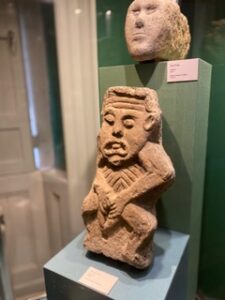 The museum houses not one but two sheela-na-gigs! For those who aren’t familiar, these are grotesques. Often found in old churches, castles, and even gateposts, these figures depict a naked female figure usually in a squatting position with her arms wrapped around her legs, hands exposing her exaggerated vulva. Intriguing, eh? Some think these explicit medieval carvings were fertility symbols. Others think they were to ward off evil. I have a map of 126 of these fascinating little ladies around Ireland, but many are on private property. To date, I’ve probably only seen a dozen or so. I could write a whole article just on these old babes. To read what Ali has to say about these on her substack article go here:
The museum houses not one but two sheela-na-gigs! For those who aren’t familiar, these are grotesques. Often found in old churches, castles, and even gateposts, these figures depict a naked female figure usually in a squatting position with her arms wrapped around her legs, hands exposing her exaggerated vulva. Intriguing, eh? Some think these explicit medieval carvings were fertility symbols. Others think they were to ward off evil. I have a map of 126 of these fascinating little ladies around Ireland, but many are on private property. To date, I’ve probably only seen a dozen or so. I could write a whole article just on these old babes. To read what Ali has to say about these on her substack article go here:
https://aliisaac.substack.com/p/september-from-goddess-to-grotesque?utm_source=substack&utm_medium=email
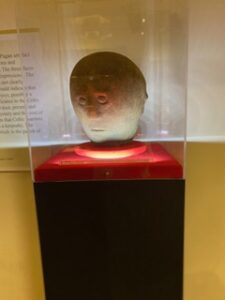 I also saw a three-faced stone head called the Corleck Head. It is an Iron age Celtic Pagan artifact, circa 100 BC, about the size of a regular head. Each face wears a different expression. The number three was of great significance to the Celtic people, and the head may represent past, present and future.
I also saw a three-faced stone head called the Corleck Head. It is an Iron age Celtic Pagan artifact, circa 100 BC, about the size of a regular head. Each face wears a different expression. The number three was of great significance to the Celtic people, and the head may represent past, present and future.
The museum also has an extensive display of items from the 1916 Rising. This time is dear to my heart, as it began the process of Ireland’s freedom from England. I believe, in a past incarnation, I was somehow involved in that Rising, as I studied it carefully, and feel like I knew the participants well. There were many other wondrous items I got to see there, and I could go on and on about it.
I met the Ukrainian woman, Victoria, who worked in the café at the Farnham Arms Hotel where I stayed. I asked her how it was that she could always have a sweet smile on her face with what her country is enduring. She told me she really didn’t have another choice. I was astonished when she said that she just had to assume there was a higher reason why it was all happening. Her mother had stayed home, as she couldn’t bear to leave her cats and dogs. My heart was deeply touched. When I left, I gave her some euros for her mother to help feed the animals and she cried. I, too, cried. Such a beautiful soul.
Returning to Dublin, I rested so as to begin my journey to County Leitrim where my friend, John Willmott lives. Like Ali, he contributed to the tour I led to Ireland in 2016. John, while originally from the Hebrides in Scotland, has lived in Florida and Utah, and now Ireland for many years and he is a walking encyclopedia of information regarding ancient Ireland. His degree is in food science, which led him to the states, but he is also a poet, an actor, a writer,teacher, and has a podcast on folklore. NatureFolklore.com He’s writing a book on Irish folklore of the four seasons, and you can read it on his substack: naturefolklore@substack.com
John lives on a verdant, tree-shaded lane in a picturesque, stone gate house with blue trim. The kitchen is delightful, with a large island in the center where he makes his bread. There are shelves filled with jars pf beans, herbs, and grains. His cat named Squeek eventually allowed me to pet him.
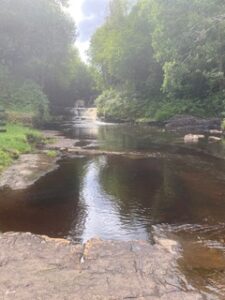 We had many adventures in the 3 days I spent there, and I’ll share a few highlights. John is big into water conservation, and he escorted me to several holy wells. He also shared a refreshing waterfall – Pol-na-Ease – which gave me a sense of peace. Some of these are named after St. Brigid. The majority of wells are called St. Patrick’s Well. The truth is, Patrick was only ever in a small part of Ireland, around County Mayo on the northeastern shore across to Armagh in the north. Surely, he didn’t visit most of these wells ever. But never mind my sense of history.
We had many adventures in the 3 days I spent there, and I’ll share a few highlights. John is big into water conservation, and he escorted me to several holy wells. He also shared a refreshing waterfall – Pol-na-Ease – which gave me a sense of peace. Some of these are named after St. Brigid. The majority of wells are called St. Patrick’s Well. The truth is, Patrick was only ever in a small part of Ireland, around County Mayo on the northeastern shore across to Armagh in the north. Surely, he didn’t visit most of these wells ever. But never mind my sense of history.
We drove to Lake Scur and spotted a courtyard tomb near the side of the road. There was a small pathway to enter the pasture, but a sign warned to watch out for the bull. Since John is on a rollator (walker), and I had been ill, we were fully aware the bull could outrun us if he was of a mind to. While the herd essentially ignored us, the bull eyed us carefully. I guarantee, we studied him, too. Eventually, he moved along with his harem and we cautiously moved forward. It was the longest portal tomb I had ever seen, and in good condition.
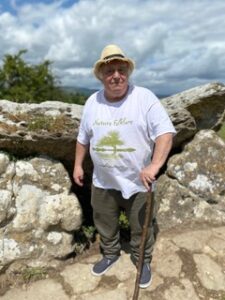 He took me to a sweet little well in a clump of holly trees and rowan in the townland of Cleighran Mor known as St. Hughes Well. St. Hughes was known for healing inflammation, blood poison and warts. There was a small waterfall there, but more interesting was the sweathouse. I had read about them, but never seen one. There have been more than 100 of them identified in County Leitrum alone. These small, sturdy, stone structures were built near water into hillsides to bolster their foundation, and used for 300 years for the medical benefits. Stones were piled and bonded with clay and sod to create a domed room with a single low entrance. Turf or wood was lit inside the sweathouse with a blocked entrance and roof vent. After a time, the embers were swept out, and a naked person would crawl into the space and stay as long as they could stand it. When they emerged, they cleansed and cooled themselves in the nearby stream. Since my beloved knee was bothering me, I chose not to crawl inside. And as far the sparkling, clear stream with pretty rocks shining next to it – too cold!
He took me to a sweet little well in a clump of holly trees and rowan in the townland of Cleighran Mor known as St. Hughes Well. St. Hughes was known for healing inflammation, blood poison and warts. There was a small waterfall there, but more interesting was the sweathouse. I had read about them, but never seen one. There have been more than 100 of them identified in County Leitrum alone. These small, sturdy, stone structures were built near water into hillsides to bolster their foundation, and used for 300 years for the medical benefits. Stones were piled and bonded with clay and sod to create a domed room with a single low entrance. Turf or wood was lit inside the sweathouse with a blocked entrance and roof vent. After a time, the embers were swept out, and a naked person would crawl into the space and stay as long as they could stand it. When they emerged, they cleansed and cooled themselves in the nearby stream. Since my beloved knee was bothering me, I chose not to crawl inside. And as far the sparkling, clear stream with pretty rocks shining next to it – too cold!
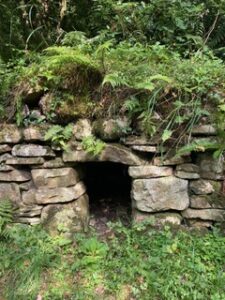 The following day, we drove around to 2 huge, mystical faery mounds. While I often see faery mounds in the landscape around Ireland, I’d never seen anything like Sheemor or Sheebeg. (It means Big Faery Mound and little faery mound in Gaelic) For the Turlough O’Carolan fans (a blind harpist in the 1700s), he wrote a tune about it called Sheebeg Sheemore. There are actually two summits, and one has a huge crucifix on it, which is so incongruous with the land. I learned that there are 3 cairns at the summit. It was believed that the Tuatha de Dannan lived underneath it. It is said that it opens up at Samhain (Halloween), releasing faeries and spirits. Wow! Listen to Turlough’s tune: https://www.youtube.com/watch?v=eItPn-EoT0g
The following day, we drove around to 2 huge, mystical faery mounds. While I often see faery mounds in the landscape around Ireland, I’d never seen anything like Sheemor or Sheebeg. (It means Big Faery Mound and little faery mound in Gaelic) For the Turlough O’Carolan fans (a blind harpist in the 1700s), he wrote a tune about it called Sheebeg Sheemore. There are actually two summits, and one has a huge crucifix on it, which is so incongruous with the land. I learned that there are 3 cairns at the summit. It was believed that the Tuatha de Dannan lived underneath it. It is said that it opens up at Samhain (Halloween), releasing faeries and spirits. Wow! Listen to Turlough’s tune: https://www.youtube.com/watch?v=eItPn-EoT0g
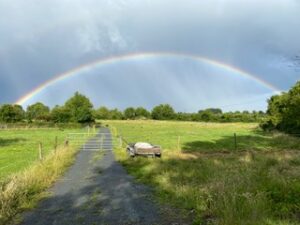 A soft rain began. Before long, we stopped to take photos of a huge rainbow that actually went all the way to the ground on both sides. It felt like a blessing, and was the perfect end of the day and the trip.
A soft rain began. Before long, we stopped to take photos of a huge rainbow that actually went all the way to the ground on both sides. It felt like a blessing, and was the perfect end of the day and the trip.
